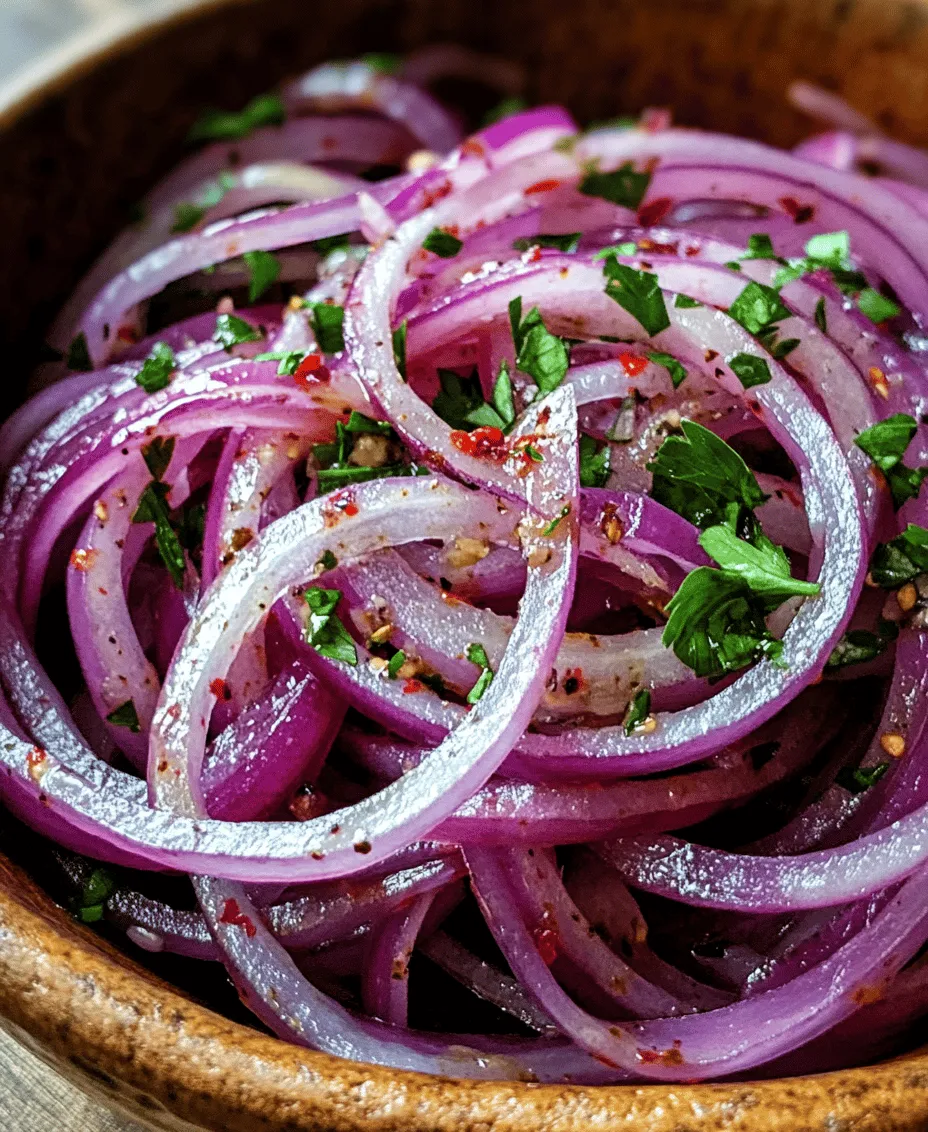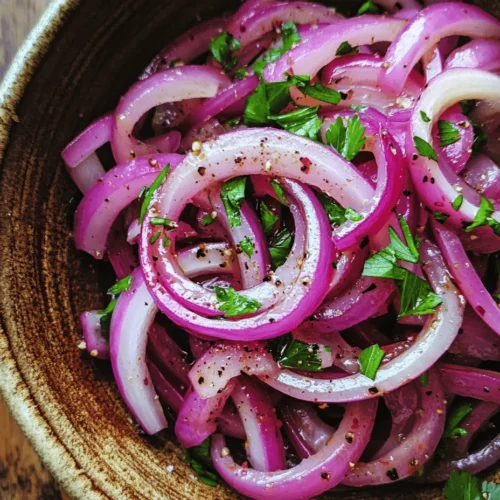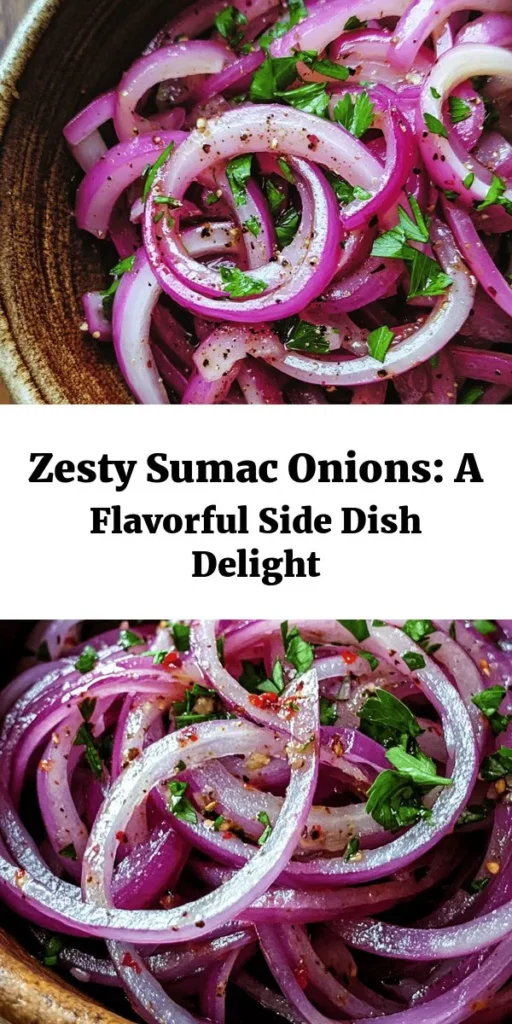Introduction
In the world of culinary delights, few ingredients can transform a dish as dramatically as onions. Their ability to add depth and character to a wide array of recipes is unparalleled. Among the many varieties of onions, red onions stand out not only for their vibrant color but also for their slightly sweet flavor that becomes even more pronounced when cooked. When paired with the tangy and slightly citrusy notes of sumac, red onions are elevated to a whole new level.
In this article, we will explore the delightful recipe for Zesty Sumac Onions, a dish that offers a burst of flavor and can serve as a versatile accompaniment to numerous meals. The striking combination of sumac, olive oil, and red onions creates a dish that is both refreshing and satisfying. Originating from Middle Eastern cuisine, sumac is a lesser-known spice that deserves a spotlight in your pantry. Join us as we delve into the ingredients, their benefits, and the preparation steps for this vibrant dish.
Understanding the Ingredients
Overview of Red Onions
Red onions, with their striking purple skin and white flesh, are a staple in kitchens around the globe. Their flavor is milder than that of yellow onions, making them a popular choice for salads, salsas, and various cooked dishes. When cooked, red onions become sweeter and develop a rich, caramelized flavor that enhances the overall taste of any dish.
Nutritionally, red onions are a powerhouse. They are low in calories yet packed with vitamins and minerals, including vitamin C, vitamin B6, and potassium. They also contain antioxidants, particularly quercetin, which has anti-inflammatory properties. Incorporating red onions into your diet can contribute to improved heart health and may even help regulate blood sugar levels.
The Role of Olive Oil in Cooking
Olive oil is another essential ingredient in the recipe for Zesty Sumac Onions. Renowned for its rich flavor and health benefits, olive oil is a staple in Mediterranean cooking. It is known for its high content of monounsaturated fats, which are beneficial for heart health. Olive oil is also rich in antioxidants, which help combat oxidative stress in the body.
In cooking, olive oil not only adds flavor but also enhances the texture of dishes. It acts as a medium for sautéing, allowing ingredients to cook evenly while retaining moisture. When preparing Zesty Sumac Onions, the olive oil helps to tenderize the onions and infuse them with flavor.
Introduction to Sumac
Sumac is a unique spice that is often overlooked. It is made from the dried and ground berries of the sumac plant, which is primarily found in the Mediterranean region and the Middle East. The flavor profile of sumac is tangy and slightly lemony, making it an excellent seasoning for a variety of dishes. Traditionally, it has been used to enhance salads, meats, and fish, but its versatility knows no bounds.
In Middle Eastern cuisine, sumac is often sprinkled over dishes as a finishing touch, adding a burst of flavor and color. It is not only a flavor enhancer but also a source of antioxidants and has been linked to various health benefits, including improved digestion and anti-inflammatory effects.
The Importance of Sea Salt in Seasoning
No dish is complete without the right seasoning, and sea salt plays a crucial role in bringing out the flavors of the ingredients in Zesty Sumac Onions. Unlike regular table salt, sea salt is minimally processed and retains trace minerals, which can add depth to the flavor profile of your dishes. The right amount of salt can enhance the sweetness of the onions and balance the tanginess of the sumac, creating a harmonious blend of flavors.
The Choice Between Red Wine Vinegar and Lemon Juice
When it comes to acidity, both red wine vinegar and lemon juice can work wonders in recipes, but they each bring their own unique flavor profile. Red wine vinegar has a fruitiness that complements the sweetness of red onions, while lemon juice provides a bright, fresh tang. In Zesty Sumac Onions, either can be used depending on your personal preference or what you have on hand.
Choosing between these two options can be guided by the overall flavor you wish to achieve. If you opt for red wine vinegar, you may find that it enhances the dish’s earthiness, while lemon juice will uplift the dish with a zestful brightness.
The Optional Chili Flakes
To add an extra layer of complexity and heat to Zesty Sumac Onions, consider incorporating optional chili flakes. This addition can elevate the dish by introducing a mild spiciness that complements the tangy sumac and sweet onions. The key is to adjust the amount of chili flakes based on your heat tolerance; just a pinch can make a significant difference without overwhelming the other flavors.
Step-by-Step Preparation of Zesty Sumac Onions
Detailed Preparation Instructions
Now that we’ve explored the ingredients and their significance, let’s dive into the preparation of Zesty Sumac Onions. This dish may seem simple, but the key to achieving the perfect balance of flavors lies in the preparation steps.
1. Slice the Onions Thinly: Begin by peeling the red onions and slicing them thinly. Thin slices ensure that the onions cook evenly and caramelize beautifully, releasing their natural sweetness. Aim for slices that are about 1/8 inch thick for optimal results.
2. Season the Onions: Place the sliced onions in a mixing bowl. Generously season them with sea salt and sprinkle in the sumac. Using your hands, gently massage the seasoning into the onions. This step is crucial as it helps to infuse the flavors deeply into the onions while also softening their texture.
3. Add Olive Oil: Drizzle the olive oil over the seasoned onions. The oil will not only enhance the flavor but also help in the cooking process. Toss the onions to ensure they are evenly coated in olive oil.
4. Choose Your Acidity: Depending on your preference, add either a splash of red wine vinegar or a squeeze of fresh lemon juice to the onions. This will brighten the dish and complement the other flavors. Mix well to incorporate the acidity.
5. Optional Heat: If you’re looking to add a bit of spice, now is the time to sprinkle in some chili flakes. Start with a small amount and adjust according to your taste.
6. Sautéing the Onions: Heat a skillet over medium heat and add a touch more olive oil if needed. Once hot, add the seasoned onions, spreading them out in an even layer. Allow them to cook undisturbed for a couple of minutes until they start to soften.
7. Stir and Cook: After a few minutes, stir the onions gently to ensure even cooking. Continue to sauté for about 10-15 minutes, or until the onions are tender and have developed a beautiful golden color. Keep an eye on them to prevent burning, adjusting the heat as necessary.
By following these initial steps, you’ll set the foundation for a flavorful and vibrant dish that can enhance salads, grilled meats, or be served as a standalone side. The combination of tangy sumac, sweet onions, and the richness of olive oil creates a dish that is as delightful to taste as it is to behold.
In the next part of this article, we will explore how to serve Zesty Sumac Onions, pairing suggestions, and additional tips for making this dish a standout on your table.

Ideal Heat Settings for Caramelization Without Burning
When preparing Zesty Sumac Onions, achieving the perfect caramelization is crucial for maximizing flavor. Start by heating your pan over medium heat; this allows for a gradual release of the natural sugars in the onions. If the heat is too high, you’ll risk burning the edges while leaving the center undercooked. A good rule of thumb is to use a non-stick skillet or a well-seasoned cast-iron pan, as these surfaces promote even cooking without sticking.
Once the onions are in the pan, keep the heat at a steady medium to medium-low setting. Stir them frequently, allowing them to soften and develop a rich golden color without charring. This process typically takes about 10 to 15 minutes, depending on the thickness of your onion slices. If you notice browning occurring too quickly, lower the heat slightly and add a splash of water or broth to deglaze the pan and prevent burning.
Signs That Onions Are Perfectly Sautéed
Perfectly sautéed onions should exhibit a translucent appearance, a soft, tender texture, and a sweet aroma. The color should transition from a sharp white or purple to a golden hue, indicating that the sugars are beginning to caramelize. If you taste them and find a rich, sweet flavor profile with no bitterness, you know you’re on the right track. Avoid the temptation to rush the cooking process; patience is key to achieving those beautifully sautéed onions that will enhance your Zesty Sumac Onions.
Importance of Adding Acidity (Red Wine Vinegar or Lemon Juice)
Adding an element of acidity to your Zesty Sumac Onions is essential for balancing the sweetness developed during the sautéing process. Both red wine vinegar and lemon juice serve as excellent choices, brightening the overall flavor profile. The acidity cuts through the richness of the onions and enhances their natural sweetness, creating a harmonious blend of flavors.
When incorporating acidity, it’s best to add it toward the end of the cooking process. This allows the vinegar or lemon juice to infuse without evaporating too much, ensuring that the tangy notes remain prominent. Just a splash or squeeze can elevate the dish, transforming it from merely good to extraordinary.
How It Enhances the Overall Flavor Profile
The addition of acidity not only balances sweetness but also adds depth and complexity to the dish. It creates a contrast that makes the flavors pop, providing a refreshing lift that can be particularly beneficial in richer dishes. The zesty notes from the sumac, combined with the acidity, create a vibrant flavor explosion that complements various culinary applications – whether served atop grilled meats, roasted vegetables, or as part of a refreshing salad.
Presentation Tips for Serving Zesty Sumac Onions
Presentation plays a vital role in elevating your Zesty Sumac Onions from a simple side dish to a stunning culinary centerpiece. To achieve an appealing presentation, consider these tips:
1. Use a Colorful Serving Dish: A white or light-colored bowl can create a beautiful contrast against the deep, golden hues of the onions, allowing them to stand out visually.
2. Layer with Fresh Ingredients: When serving, layer the onions with fresh herbs, such as parsley or cilantro, to add vibrant color and freshness. This not only enhances the visual appeal but also contributes to the flavor.
3. Garnish Thoughtfully: A sprinkle of sumac on top of the onions before serving can reinforce the dish’s flavor and provide a pop of color.
4. Add Texture: Consider sprinkling some toasted nuts or seeds on top for an added crunch that complements the soft texture of the onions.
Importance of Garnishing with Fresh Parsley
Garnishing with fresh parsley not only adds a burst of color but contributes a refreshing herbal note that enhances the flavor of the Zesty Sumac Onions. Parsley is often used in Middle Eastern cuisine, complementing the tangy sumac and sweet onions beautifully.
Moreover, fresh herbs like parsley are rich in vitamins and antioxidants, making them a healthy addition to your dish. Scatter a handful over the top just before serving to maintain its vibrant green color and fresh flavor.
Serving Suggestions for Enhancing the Dish Visually
To serve Zesty Sumac Onions, consider pairing them with a variety of complementary dishes that enhance both the visual appeal and the flavor experience:
– Grilled Meats: The smoky flavors of grilled chicken, lamb, or beef serve as a perfect backdrop for the zesty onions, creating a balanced and flavorful plate.
– Vegetable Dishes: Roasted or grilled vegetables, such as bell peppers, eggplant, or zucchini, can be beautifully plated alongside the onions, creating a colorful and nutritious spread.
– Middle Eastern Spreads: Serve Zesty Sumac Onions with a platter of hummus, baba ghanoush, and pita bread for a delightful mezze experience that highlights Middle Eastern flavors.
Culinary Pairings and Serving Suggestions
Ideal Dishes to Serve Alongside Zesty Sumac Onions
Zesty Sumac Onions are incredibly versatile and can enhance a multitude of dishes. Here are some ideal pairings to consider:
– Grilled Meats and Vegetables: The savory nature of grilled meats, such as chicken, lamb, or fish, pairs splendidly with the zesty acidity of the onions. The onions can be served on the side or atop the grilled items, adding a burst of flavor.
– Middle Eastern-Inspired Spreads and Dips: Zesty Sumac Onions can elevate your mezze platter, serving as a fresh contrast to creamy dips like tzatziki, hummus, or baba ghanoush. Pair them with warm pita or flatbread for a delightful appetizer.
– Salads and Wraps: Incorporate Zesty Sumac Onions into salads for a flavor boost. They work well in grain bowls, green salads, or as a topping for wraps and sandwiches, providing a refreshing crunch and tanginess.
– Creative Incorporations: Use Zesty Sumac Onions in various cuisines. They can be stirred into pasta dishes, added on top of tacos, or mixed into stir-fries, showcasing their versatility across culinary borders.
Health Benefits of Zesty Sumac Onions
Nutritional Analysis of the Ingredients Used
Zesty Sumac Onions feature simple yet nutrient-dense ingredients: onions, olive oil, sumac, and vinegar.
– Onions: Rich in vitamins C and B6, folate, and potassium, onions are known for their anti-inflammatory properties. They are low in calories, making them a great addition to any meal.
– Olive Oil: A primary source of healthy fats, olive oil is packed with antioxidants and is beneficial for heart health. It enhances the absorption of fat-soluble vitamins from other ingredients.
– Sumac: This spice is high in antioxidants and has anti-inflammatory properties. It can also aid digestion and regulate blood sugar levels.
Benefits of Consuming Onions and Olive Oil
Onions are not just flavorful; they are also a powerhouse of nutrients. Their high antioxidant content, particularly quercetin, helps combat oxidative stress in the body. Olive oil, recognized for its heart-healthy benefits, is a staple in Mediterranean diets, promoting overall wellness.
Antioxidant Properties of Sumac
Sumac is often overlooked but is a rich source of antioxidants. These compounds help protect the body from free radicals, reducing the risk of chronic diseases. Incorporating sumac into your diet can also enhance your immune system and improve digestion.
Discussing Dietary Considerations (Vegan, Gluten-Free, etc.)
Zesty Sumac Onions are naturally vegan, gluten-free, and suitable for various dietary preferences, making them an excellent addition to diverse meal plans. They can easily be incorporated into plant-based diets or enjoyed alongside non-vegetarian dishes without any modifications.
The Role of Fresh Herbs in Enhancing Health and Flavor
Fresh herbs, like parsley, not only enhance the flavor of your dishes but also provide additional health benefits. They are often rich in vitamins A, C, and K, and can support overall health when included in daily meals.
Cultural Significance of Sumac and Onions in Cooking
Historical Background of Sumac in Culinary Traditions
Sumac has a rich history in culinary traditions, particularly in Middle Eastern and Mediterranean cuisines. Its tart flavor has made it a staple seasoning for centuries, often used to brighten up dishes and provide a unique flavor profile. Historically, sumac was valued not just for its culinary benefits but also for its medicinal properties.
The Role of Onions in Different Global Cuisines
Onions are a universal ingredient found in nearly every cuisine worldwide. They serve as a foundational flavor in dishes ranging from French onion soup to Indian curries, showcasing their versatility and importance in cooking. In many cultures, onions symbolize hospitality and are integral to traditional recipes.
How Zesty Sumac Onions Represent a Fusion of Flavors
Zesty Sumac Onions exemplify a fusion of flavors that transcends culinary boundaries. By combining the sweetness of caramelized onions with the tartness of sumac and the brightness of acidity, this dish beautifully represents the melding of different culinary traditions, offering a taste experience that is both familiar and unique.
Conclusion
Zesty Sumac Onions are a compelling example of how simple ingredients can come together to create a dish that is both versatile and packed with flavor. Their adaptability allows you to explore a variety of culinary contexts, from serving them alongside grilled meats to incorporating them into vibrant salads.
With their health benefits and cultural significance, Zesty Sumac Onions are a celebration of fresh, vibrant ingredients that can enhance any meal. Embrace the joy of cooking with these flavorful onions, and let your culinary creativity flourish as you discover new ways to enjoy this delightful dish. Whether you are preparing them for a family gathering or a casual dinner, Zesty Sumac Onions are sure to impress and inspire.



